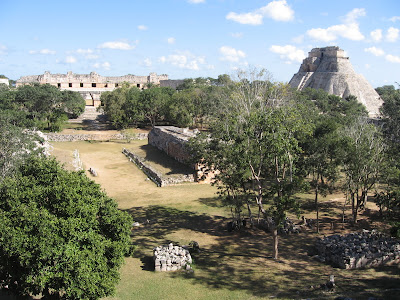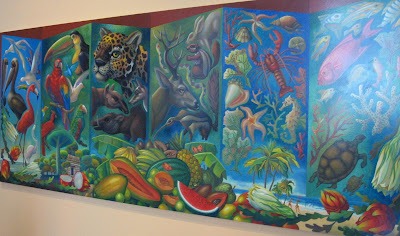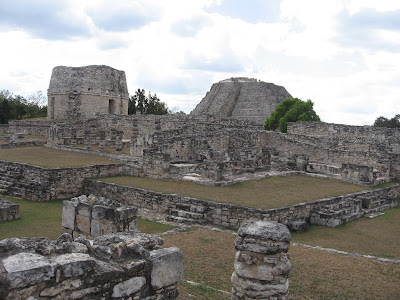Thursday 31st January 2008, Merida, Mexico
Yesterday at Uxmal the hotel staff sent us up a couple of flights of stairs with our luggage, only to discover our allocated room was already occupied. Today they made up for it by carrying our luggage out and loading it onto the coach for us. Unfortunately it wasn't our coach! We discovered in time but really we do seem to have encountered an inordinate amount of muddle from hotel staff during this trip.
We spent the morning at the site of Uxmal. When we arrived at 8am it was reasonably fresh but by the time we left at midday we were definitely finding clambering around ancient walls in 34 degrees of bright sunlight very draining. We became so used to the huge iguanas posing motionless on the walls, or hiding in culverts with their tails sticking out, that we ceased to be intrigued by them. There were dozens around the site and they seemed to change their colour according to whether they were on grey stone walls or amongst the green bushes.
Uxmal was occupied during the classic period and most of the visible buildings date from around the eighth and ninth centuries. It is also a town that survives into the historical period recorded at the time of the Spanish conquest. For a while in the 11th century it was part of the league of cities which included Chichen Itza. The centre of power then shifted to Mayapan until in 1441 the Xiu rulers of Uxmal threw off their yoke. During the conquest the Xiu family allied themselves with the Spaniards.
The Pyramid of the Magician, supposedly built in a single night, lies at the entrance to the site, unusual on two counts, firstly because of its rounded corners and secondly because, when it was reconstructed the additions were built not over the top, but just behind it, leaving the older stairway and temple still visible on one side.

The buildings are decorated with geometrical mosaics of stone – our guide described the site as poetry in stone and the friezes were certainly invocations to Chac, the god of rain, so many of the creatures depicted were associated with water and fertility. There were reliefs of birds and the feathered serpent wound its way along the tops of the lengthy buildings. Perhaps the most perfect and most elaborate complex was the so-called Nunnery with buildings around four sides of the quadrangle where the sound and light show was held. The Maya cleverly allowed for perspective to prevent distortion in the lines of the long buildings.



Beyond the ball-court, which had rings rather than markers the House of the Governor stood in a prominent position near the Grand Pyramid. Probably its original function is represented by the name the Spaniards gave it. There is the figure of a ruler placed centrally on the long façade and in front of it is a jaguar throne on a raised dais.



To one side of the Governor's palace is the House of the Turtles, perhaps the simplest and most classical in style of the buildings with turtles on the cornice above the colonnades.



The site of Uxmal is the most highly developed for tourists of any we have seen so far and has been visited longer than most as it is fairly accessible.
Our tame Mexican archaeologist Coral later introduced Ian to the refreshing drink of Pulque which she adores. It is made from the fermented juice of the agave plant. Chilled and drunk from the can it is very refreshing. It is also alcoholic and Ian was feeling quite contented with the world by the time we reached Merida about 1pm!

This afternoon we left our travelling companions and set off to discover the delights of the town. We had imagined Merida as a beautiful Spanish colonial town filled with impressive parks, churches and residential buildings. All these do exist but they need seeking out. Today Merida is the capital of the Yucatan region with a population of 600,000. Almost all have Mayan blood to a greater or lesser degree, mixed with Spanish. They are called Mestizos. Generally they are quite small, tending to be stocky but the children in particular are quite beautiful. Most speak Mayan as well as Spanish and many signs are written in both languages. We have been surprised that there are so few older people to be seen on the streets. Most of the population is under 35 and seems to consist of only two generations. It is quite rare to see men over 45 and we have seen very few women older than about 40! When we do, they are usually praying inside a church or begging at the door.

Merida city centre is mainly low rise buildings laid out in a grid system with the roads unimaginatively named Calle 43 – 69. Even numbers run north to south and odd numbers from east to west and a one-way system keeps the traffic flowing quite freely. The streets all look much the same and the town map must surely be the most boring one in Ian's collection! However, we found our way to the municipal market where we bought a cheap lunch of mushroom and cheese burritos with cream and salsa, with chilled lime juice to drink. Walking slowly and seeking the shady side of the streets we then made our way across town to the Anthropological museum housed in a large and beautiful villa of the colonial period. It was well worth the exhausting drag across town and we wallowed in the air conditioned rooms as we looked at the artefacts gathered from the sites of Uxmal and Chichen Itza. Pottery, carved or clay figures, knives, daggers and tools chipped from flint, offerings to the gods made from jade - ornaments, bracelets and necklaces. There were even skulls that had been deformed to produce the typically shaped heads of the Mayan elite nobility. (Babies and young children had their skulls compressed between blocks of wood to make it pointed at the top with the nose coming straight down from the forehead.)

As we made our way back towards the town centre we discovered we were in the middle of the carnival. Somebody explained that it was day five of a ten day celebration and this afternoon it had been the parade of the children. The streets had been closed to traffic and were lined with citizens standing in the hot sunshine watching the children as they passed. As the parade ended around 6pm and darkness fell, the procession broke up and hundreds of cute kids dressed as Egyptian goddesses, geisha girls, ballet dancers, princesses, pirates, Roman legionaries, cowboys and Chinese emperors trotted along with their parents, blowing bubbles, eating candyfloss and buying doughnuts and soft drinks from the many street stalls.


The central square lies between streets 60, 61, 62 and 63. Around it stand the Cathedral, the 16th century house of the conqueror Montejo, which stayed in possession of the family until the 1980s but is now a bank. Over the main entrance is a representation of the conquering Spaniards trampling Maya underfoot – which has surprisingly survived a series of periods of unrest by the suppressed Maya.


We looked inside the rather stark Cathedral built in the 16th century with stones taken from the city of Tihoo which formerly stood on the site. The interior had been stripped of its decorations during one of the uprisings. We also went inside the elegant Governor's Residence with its colonnaded courtyard. On the stairway and the first floor are a series of powerful murals by the local artist Pacheco painted over a period of 25 years and depicting the Maya cosmology and a series of historic incidents which placed so much of what we had seen in context - the conquest, the destruction of the Maya writings by Bishop Landa, the English pirates, the arrival of the printing press as recently as 1813, the Caste Wars of the early 19th century, the selling of prisoners as slaves to Cuba and recent land reforms. We were fortunate to see them as an official meeting was just finishing in the main hall as we arrived. In fact everything seemed to be happening today in Merida and the place was extremely crowded. In the crowds there was an attempt made to open our rucksack but fortunately they picked an empty pocket.




Finally, we stopped for supper at a restaurant that looked slightly less of a tourist trap than the others with a few Mexicans eating there as well. It was quite pleasant but not particularly good value. We chose Poc Chuc because it sounded exotic. When it came we realised it was actually Pork Chop! However, it was served with fried beans, caramelised onions and tomatoes and lots of green guacamole.
Friday 1st February 2008, Piste near Chichen Itza, Mexico
We were not due to leave Merida until midday so we were up and out early this morning, making the most of the relative cool before the day heated up. First though, a cup of coffee at a baker's shop with Mexican hot cakes smothered in honey and cream. We expected pancakes but these were far more substantial. Though very nice, even the two of us sharing a plateful couldn't manage to finish them!
We made our way across town to the Municipal Museum, recently installed in the former Post Office, which turned out to be completely free and blissfully air conditioned. Several groups of school children were being taken around by their teachers and were enjoying it all immensely. This museum was of particular interest, dealing not with the ancient history of the Mayan civilisation, but with their living conditions during the 19th century and the caste wars as they struggled for recognition. One of the poorest and most remote of the Mexican states, Yucatan quickly became the richest during the second half of the 19th century when the commercial value of Henequen was realised. This is a plant, indigenous to the Yucatan. Its leaves produce fibrous strands that can be twisted and woven to form string, sacking, matting and hammocks. It is known in Europe as Sisal after the port through which it was exported a short distance north of Merida. As most of the land in the Yucatan was owned by a few wealthy landowners they became extremely rich while the Maya Indians worked almost as slaves to maintain the industry.

Upstairs the museum had several temporary exhibitions including paintings by local artists depicting scenes from Merida and animals of the Yucatan peninsular.


We discovered the huge food market filled with fruit, vegetables, courges and cooked meats. It is quite astonishing just how many peppers are consumed in Mexico. There were countless long stalls laden with every possible variety and colour of pepper. Their piquancy varied from mild to white hot though they all looked deceptively fresh, shiny and innocent. Just in case a basket load of red hot chillies proved insufficient for a quick family snack, there were stalls selling large bags of dried, ground chillies that could surely have kept the entire UK supplied for months!


It was here that we discovered where the older population of Merida was to be found. The men were stallholders while the ladies were buying the food for the family. Unlike the younger women, who all wear fashionable western clothes, these ladies were wearing the traditional dress of the Yucatan consisting of a colourfully embroidered white smock known as a huipil over a longer lacy petticoat. For them the market was a meeting place and they were standing in shady corners chatting together. Such a sight may well die out. We cannot imagine the younger generation of women choosing to disappear from general view, confining themselves to their homes and forsaking their jeans and smart sandals for the traditional dresses of their mothers.
Time was passing quickly and the streets were too hot and crowded to hurry back to our hotel, so we contented ourselves with popping in to just one church as we passed by. It proved an interesting experience. Although the churches here are far less ostentatious than in Spain the statues of the saints are life size and fully dressed in velvet robes trimmed with braid and lace. Strategically placed beside the altar of this church there was a life-sized depiction of the Last Supper with Christ and the apostles. In front was a pew where a lady stood fervently praying aloud to the statues around the table. In another corner, a particularly tragic Christ robed in scarlet velvet, was being caressed by a mother and son as they stood before it. Catholicism is still very much the dominant faith amongst the people of the Yucatan - though we have seen a number of very different religious sects including even an Ebenezer Chapel where we were cheerfully waved to when we peeped in at the door!


During the afternoon we drove to Mayapan. The buildings to be seen there are scaled-down versions of what we will see tomorrow in Chichen Itza, and the site has often been deprecated for this reason. Nevertheless its importance is now being realised by archaeologists. After the fall of Chichen Itza, probably about 1200, it became the leading city in Yucatan for two centuries. Like Chichen it has a Castillo or main pyramid, here known as the Castillo of Kukulcan, the reputed founder of the city. From the top are wonderful views across the central buildings and over the flat scrubby woodlands of Yucatan. To one side of the Castillo is a round building with a remarkable circular passageway inside, rather like the Caracol in Chichen, regarded as an astronomical observatory, although without any real evidence. Just below it by a small temple is an overgrown cenote. Unlike chultunes or cisterns, these are natural holes, produced where the limestone surface has collapsed to reveal underground caves, often providing a supply of water – vital in such a parched area. The Spaniards named them from the Maya word dzonot.




There are also many administrative and residential buildings with extensive use made of columns to produce larger and lighter interiors. Unlike in the highlands, government seems to have been by council rather than by an individual, and the so-called Hall of the Kings just below the Castillo has a particularly long gallery to allow for the number of dignitaries to be accommodated. The decorations and sculptures on the site include fragments of frescoes and have the military themes derived from Toltec influence which showed close links with central Mexico. In one place fragments of floor plaster remains, showing that the floors too were decorated, with use of Maya blue as a background to patterns, and there was evidence of at least six layers of plaster, indicating a lengthy period of occupation of that level.

The heat and the number of sites we have now visited are definitely taking their toll of all but a hardy few. Despite the heat, Ian clambered to the top of the steep-sided pyramid, camera in hand, for some general views over the site while those with more sense sheltered under the shade of a fluffy kapok tree and watched. His descent was less elegant, accomplished backwards, rather like coming down a ladder.
We are now at a rather plush hotel near the famed site of Chichen Itza which we will visit tomorrow. There is little to see along the scruffy stretch of road that passes for a village outside the gates of the hotel, but this evening we ventured out to discover it is carnival here to night. It's far less boisterous and noisy than our experience in Trinidad last year, but has caused great excitement amongst the people of the village. Like the parade in Merida yesterday, all the children were in fancy dress. They were being transported up and down the only street in balloon-covered lorries, jeeps and even a peddled rickshaw. Long tailbacks of traffic built up, there was lots of hooting, drowned out by the boisterous music, and generally a good time was had by all. Compared with Jouvert at Couva last year it was a tame affair, but for anyone who'd not experienced Trinidad's unique version of Dante's Inferno it was a pretty noisy affair.


